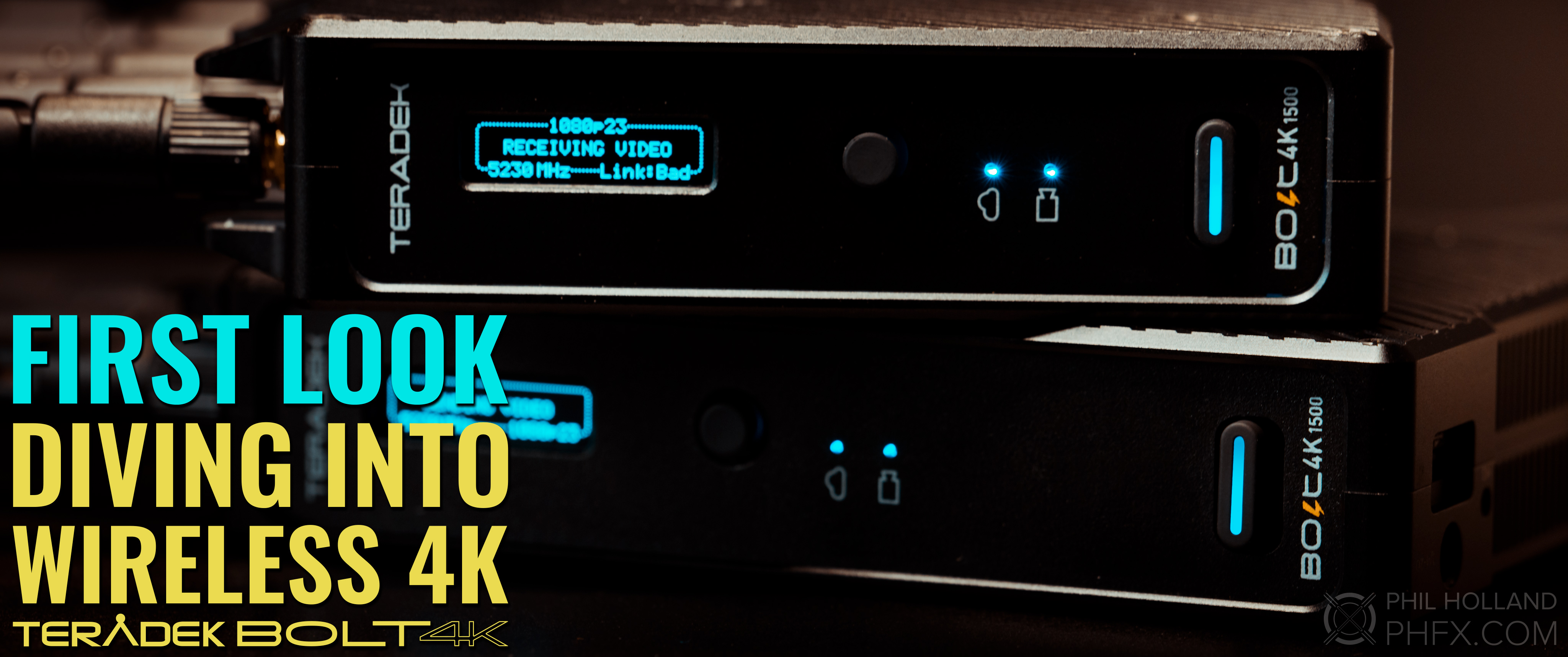 April 2019 at NAB Teradek snuck in and announced an industry first Zero-Delay wireless tranceiver and receiver with the Bolt 4K. Many of you reading this likely know how deeply wireless video on set has effected our industry and day to day work. It's empowered faster setups, minimal rigging, and is generally far more convenient than being tethered to an growing tangle of cables dangling off of the camera to get that video feed out to all those who need it.
April 2019 at NAB Teradek snuck in and announced an industry first Zero-Delay wireless tranceiver and receiver with the Bolt 4K. Many of you reading this likely know how deeply wireless video on set has effected our industry and day to day work. It's empowered faster setups, minimal rigging, and is generally far more convenient than being tethered to an growing tangle of cables dangling off of the camera to get that video feed out to all those who need it.This essentially is a quick first look at the new Teradek Bolt 4K as I'm investigating it, testing it, and I'll share a bit of perspective on where I see things heading within the industry in regards to higher quality wireless video, HDR, and the progressive movement towards more 4K based workflows.
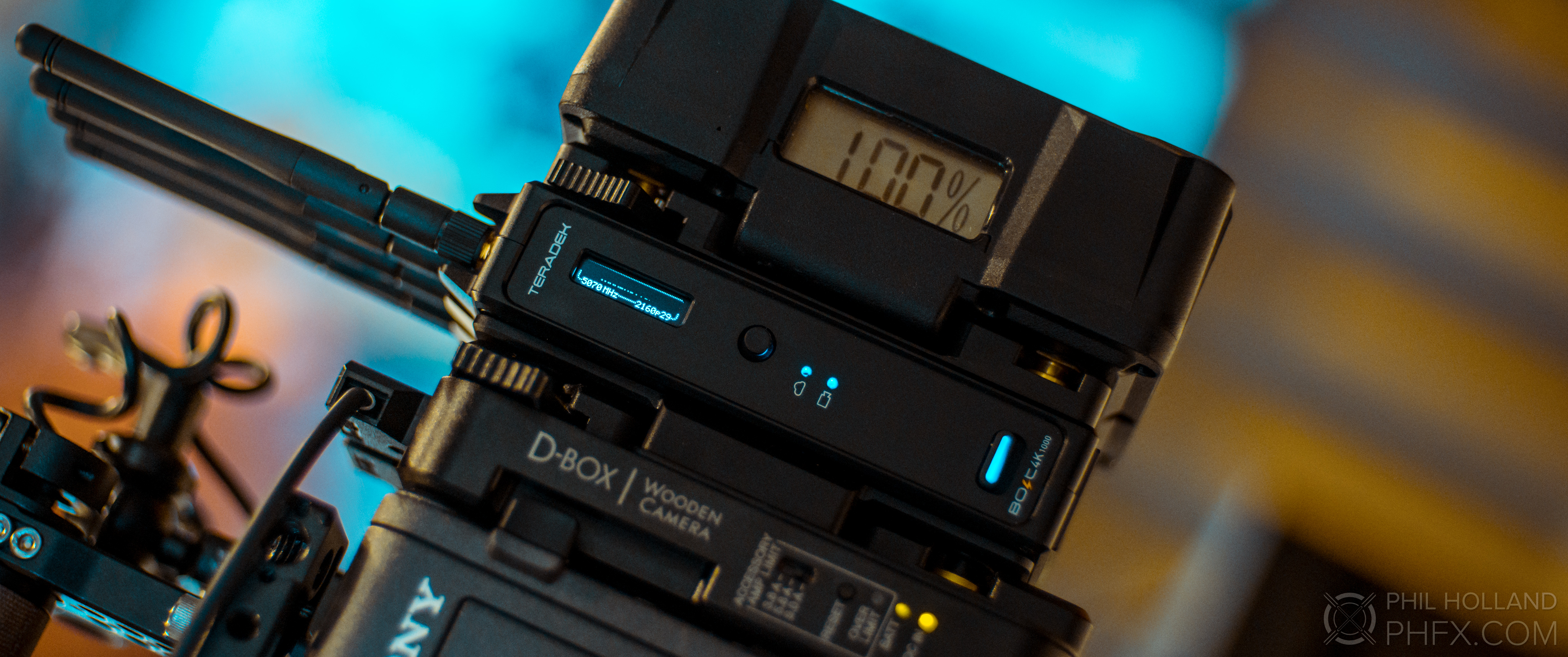
Teradek Bolt 4K mated to a Sony Venice via Gold Mount
After NAB I naturally I had a lot of deeper questions surrounding this technology and Teradek was kind enough to go deep into the backbone and inner workings of the new tech. Here's the quick brief on the features of the Bolt 4K. The Bolt 4K 1500 Tranciever (TX) has a 1500 foot range via line of site and can multi-cast to up to 6 Receivers (RX). That's improved upon the previous generation which tops out at 4 RX units. Also, as new Bolt 4K units are released that support additional ranges (750 feet, 1500 feet, etc) the RX units will be universally compatible moving forward. Signal-wise, the Bolt 4K supports and pushes out a 10-bit 4:2:2 signal at up to DCI 4K (4096x2160) 60 fps via 12G SDI or HDMI 2.0. In the image above, you can see the Bolt 4K is now mounted "modular train style" to the rear battery plate of the camera with power passthrough even when you have the TX powered off.
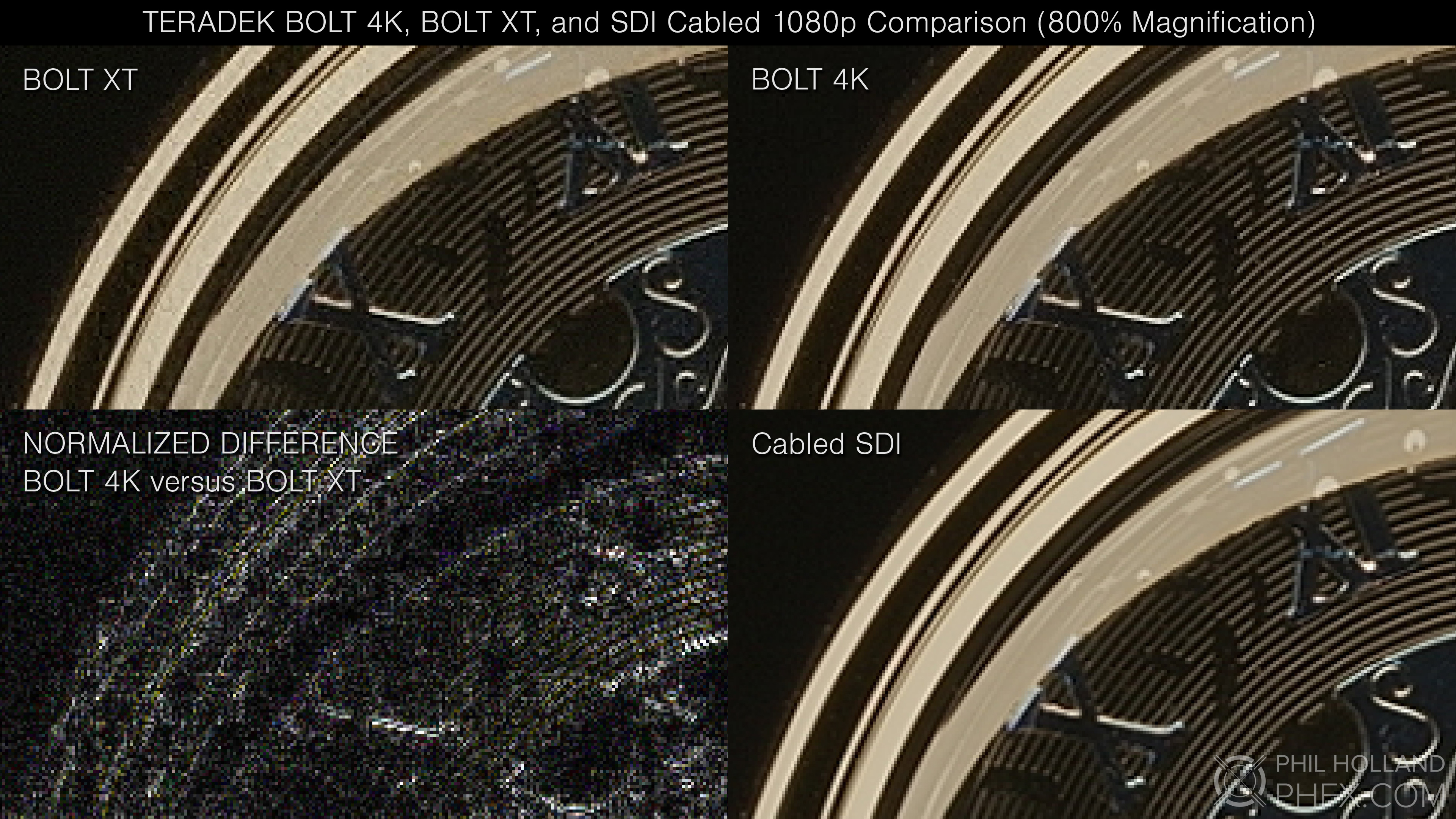
Bolt XT and 4K compared to the straight SDI Feed, 800% Magnification
The specs look good, but there's something even more interesting than that going on under the hood especially if you're familiar with the Teradek Bolt family of products. Inside the Bolt 4K is an entirely new way of handling the signal and transmitting it out. There's been a significant improvement of image quality which results in less artifacts even when comparing HD 1080p signals with previous generation Bolts. The Bolt 4K more accurately reproduces details, better performance around high frequency detail, and certainly a less jaggy visualization of image noise and is much closer to a straight cabled SDI connection. This is even more apparent in motion and on larger displays. This to me pretty much makes up the difference between a mere monitoring signal versus one you can actually broadcast, and this is where some of my POV on using this for live streaming and events comes into play. The above image is actually UHD 4K image composite of the magnified crops, so if you really want to pixel peep, download it or look at it in a new windows.
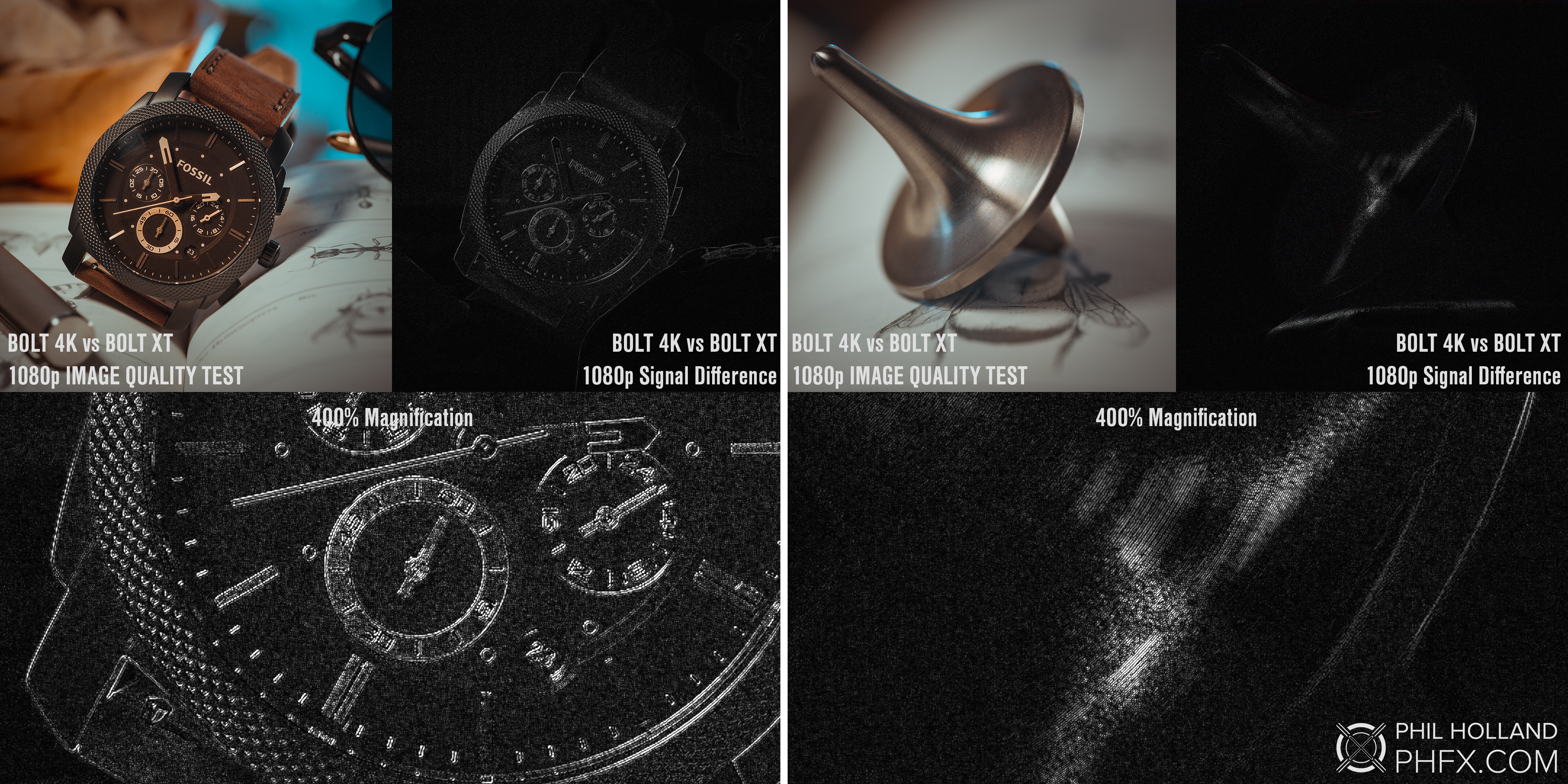 One thing I was also looking into was what exactly happens when you feed the TX a 4K signal and the RX is connected to say a 1080p monitor. The image scales accordingly to have correct signal output to the connected device, which is a nice touch. I can certainly see a world on set where perhaps a larger 4K display will be setup in Video Village and a Bolt 4K RX will also be connected to say a smaller Focus Puller's Monitor and similiar reasons to go with smaller handheld monitors if you need to roam about while watching the feed. Also equally important here for the rental houses out there is to ensure compatibility between 2K or 4K workflows.
One thing I was also looking into was what exactly happens when you feed the TX a 4K signal and the RX is connected to say a 1080p monitor. The image scales accordingly to have correct signal output to the connected device, which is a nice touch. I can certainly see a world on set where perhaps a larger 4K display will be setup in Video Village and a Bolt 4K RX will also be connected to say a smaller Focus Puller's Monitor and similiar reasons to go with smaller handheld monitors if you need to roam about while watching the feed. Also equally important here for the rental houses out there is to ensure compatibility between 2K or 4K workflows.Let me break of from the tech stuff and talk a bit about industry trends and my interests in 4K Wireless Video and HDR Monitoring. Between December 2018 through March 2019 a good deal of my professional efforts were surrounding new and upcoming streaming services. This will become even clearer around Fall/Winter 2019, but the general spoiler alert is all of these studios are focused on 4K Delivery and HDR. This is on top of the few streaming services and motion picture studios already delivering this way ahead of the incoming wave of productions. HDR is becoming a normal part of on set monitoring and you will see a lot of growth here too. The Bolt 4K fully supports HDR10, PQ, and HLG with extended metadata for things like Timecode and Wireless Record Start/Stop Triggering.

Bolt 4K connected to the upcoming 24" DCI 4K HDR Swit Production Monitor
This is a combined effort when it comes to HDR and 4K, both are growing trends and it's moving at a fast pace now. I would say from my corner of this industry, within just about 3-6 months the interest, desire, and need for 4K Monitoring on set rapidly increased. Over the course of the last month I've been diving deep into some of the new and upcoming 4K Production and Reference Monitors that will be coming to the market in 2019 and 2020. A year ago, we weren't even talking about 4K monitoring on set because there were no real wireless solutions and the cameras just begain sprouting up. Now and moving forward you will see the upcoming and latest Digital Cinema Cameras supporting 4K out. Notably the most recent Panavision DXL2 and Sony Venice cameras already both support 4K out.Monitoring off camera is a given, and I see a bigger picture going on outside potential on set use where DITs and Live Grading will be pushed out to likely larger 4K displays on set for realtime review. And taking a look forward into the future as faster mobile connections as well as streaming trends throughout the "In Real Life" and common gaming related content, you will begin to see more and more live 4K broadcasting through outlets like YouTube, Twitch, and other entities. This will cross over to coverage of things like ESports as well as mainstream competitive athletics. Very much like the early tests of 4K and 8K broadcasting I see a bunch of potential in high quality wireless 4K signal for live applications. Possibly even for ENG related work within say a 300-ish foot range in a venue space.
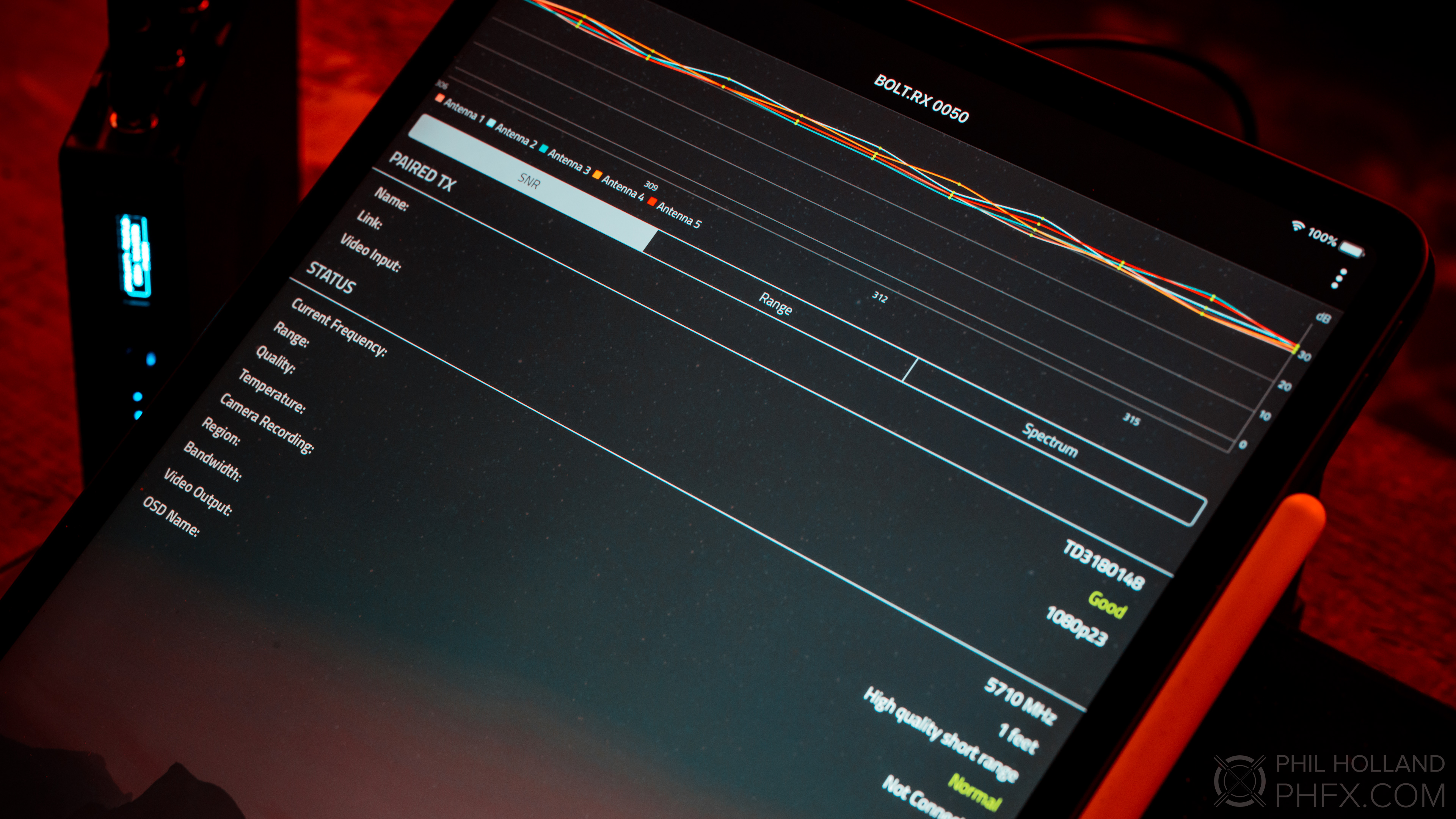
The new Teradek Bolt IOS App
Back to the Bolt 4K. With all of this the question of reliability and ease of use come into play for me. Performing a few basic distance tests over line of site, it's sort of the usual good news on signal strength. And now there's some new improvements to the ecosystem for determining signal health and monitoring various tranceivers and receivers via the new Bolt IOS App. Pairing can be done on the TX/RX combos easily, just like before and actually Teradek even added a slightly larger joystick as well as a very visible power button, which is a nice touch. But imagine yourself in a situation where you may have multiple units on set and you want to pair, monitor, upload 3D LUTs, etc. Previously you'd likely approach individual units to change their settings, but with the new Bolt App you can from an iPhone or iPad quickly navigate in and out of your TX and RX units, assign them names, change their settings, and monitor signal strength all from one compact device that can fit in your pocket.
 The Bolt 4K begins shipping next month, August 2019, and it's been an interesting dive into the new tech. Personally for my workflow this is an easy addition to my kit as I specialize in high resolution motion picture production. The signal image quality improvements honestly have taken me by surprise when doing the side by sides, even at 1080p resolution and have certainly inspired some thought on how this might apply to new 4K streaming efforts. I should stress that not all signals need to be of a broadcast quality, especially if it's general focus pulling or monitoring takes. But I've seen the sliding trend towards larger production monitors on set and the need for a better quality wireless signal. With the more demanding image quality needs of a 4K and HDR production, this is an area to watch closely in the next 12-18 months as productions move more towards 4K on set and delivery, it's pretty obvious that tools like these need to exist. But I think the shocking thing for many will be is exactly how fast we get there in that timeframe.
The Bolt 4K begins shipping next month, August 2019, and it's been an interesting dive into the new tech. Personally for my workflow this is an easy addition to my kit as I specialize in high resolution motion picture production. The signal image quality improvements honestly have taken me by surprise when doing the side by sides, even at 1080p resolution and have certainly inspired some thought on how this might apply to new 4K streaming efforts. I should stress that not all signals need to be of a broadcast quality, especially if it's general focus pulling or monitoring takes. But I've seen the sliding trend towards larger production monitors on set and the need for a better quality wireless signal. With the more demanding image quality needs of a 4K and HDR production, this is an area to watch closely in the next 12-18 months as productions move more towards 4K on set and delivery, it's pretty obvious that tools like these need to exist. But I think the shocking thing for many will be is exactly how fast we get there in that timeframe.






